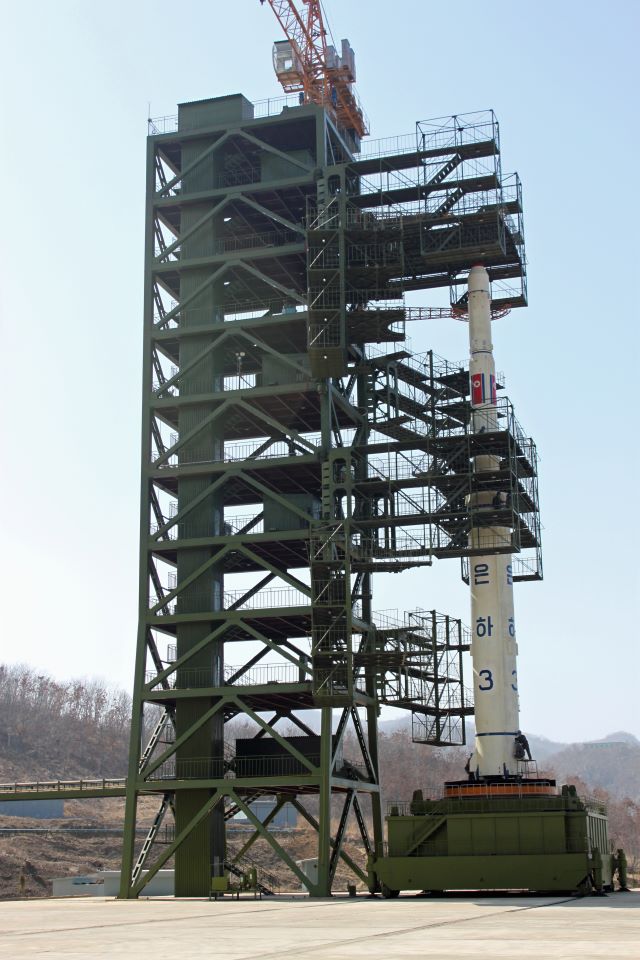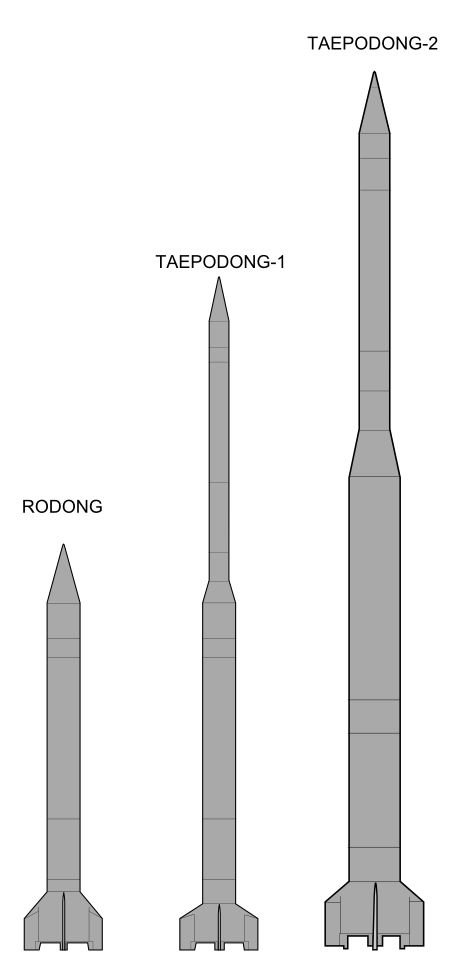|
Unha
The Unha or Eunha ( ko, 은하, 銀河, "Galaxy") is a North Korean expendable carrier rocket, which partially utilizes the same delivery system as the Taepodong-2 orbital launch system. History North Korea's first orbital space launch attempt occurred on August 31, 1998, and was unsuccessful. This launch attempt was performed by a Paektusan-1 rocket, which used a solid motor third stage, a Scud-missile-based second stage, and a Nodong-1 based first stage. Nodong-1 was a North Korean-developed stage thought to be a scale-up of the old Soviet Scud missile. The Paektusan-1 stood tall, was in diameter, and weighed about 21 tonnes. Vehicle description The Unha's first stage consists of four clustered Nodong motors, which themselves are enlarged Scud motors. The second stage was initially thought to be based on the SS-N-6, although it, too, is now believed to be based on Scud technology. The third and last stage might be identical to the Iranian Safir's second stage which is ... [...More Info...] [...Related Items...] OR: [Wikipedia] [Google] [Baidu] |
National Aerospace Development Administration
National Aerospace Development Administration (NADA; ) is the official space agency of North Korea, succeeding the Korean Committee of Space Technology (KCST). It was founded on April 1, 2013. The current basis for the activities of NADA is the Law on Space Development, in 2013 the 7th session of the 12th Supreme People's Assembly was passed. The Act sets out the North Korean principles of peaceful development of space determines compliance with the principles of the Juche ideology (North Korean ideology) and independence, as well as the aim of solving scientific and technological problems of space to improve the economy, science and technology. The law also regulates the position of the NADA and the principles of notification, security, research and possibly compensation in relation to satellite launches. The law calls for cooperation with international organizations and other countries, the principle of equality and mutual benefit, respect for international law and internation ... [...More Info...] [...Related Items...] OR: [Wikipedia] [Google] [Baidu] |
Taepodong-2
The Taepodong-2 (TD-2, also spelled as Taep'o-dong 2) Federation of American Scientists, May 30, 2008 ( ko, 대포동 2호) is a designation used to indicate what was initially believed to be a n two or three-stage design that is the successor to the Taepodong-1 technology demonstrator. In 2012 the U.S. Department ... [...More Info...] [...Related Items...] OR: [Wikipedia] [Google] [Baidu] |
Paektusan (rocket)
Taepodong-1 ( ko, 대포동-1) was a three-stage technology demonstrator developed by North Korea, a development step toward an intermediate-range ballistic missile. The missile was derived originally from the Scud rocket and was tested once in 1998 as a space launch vehicle. As a space launch vehicle, it was sometimes called the Paektusan 1. History On August 31, 1998, North Korea announced that they had used this rocket to launch their first satellite Kwangmyŏngsŏng-1 from a pad on the Musudan-ri peninsula. However, the satellite failed to achieve orbit; outside observers conjecture that the additional third stage either failed to fire or malfunctioned. This is contrary to official statements of the North Korean state media, which stated that the satellite achieved orbit about 5 minutes after launch. On this single launch, the main two-stage booster flew for 1,646 km without any significant problems. The rocket was launched eastward, passing over Japan at an altitud ... [...More Info...] [...Related Items...] OR: [Wikipedia] [Google] [Baidu] |
Kwangmyŏngsŏng-3 Unit 2
Kwangmyŏngsŏng-3 Unit 2 or Gwangmyeongseong-3 ho 2-hogi (; English: Bright Star-3 Unit 2 or Lodestar-3 Unit 2) is the first satellite successfully launched from North Korea, an Earth observation spacecraft that was launched on 12 December 2012, 00:49 UTC, in order to replace the original Kwangmyŏngsŏng-3, which failed to reach orbit on 13 April 2012. The United Nations Security Council condemned the satellite launch, regarding it as a violation of the ban on North Korean ballistic missile tests, as the rocket technology is the same. The launch came during the period when the DPRK was commemorating the first anniversary of the death of former leader Kim Jong-il and just before the first South Korean domestic launch of a satellite and the South Korean presidential election on 19 December 2012. The successful launch makes the DPRK the tenth space power capable of putting satellites in orbit using its own launch vehicles. North Korea declared the launch successful, and the ... [...More Info...] [...Related Items...] OR: [Wikipedia] [Google] [Baidu] |
Kwangmyŏngsŏng-3
Kwangmyŏngsŏng-3 () was a North Korean Earth observation satellite which, according to the DPRK, was for weather forecast purposes, and whose launch was widely portrayed in the West to be a veiled ballistic missile test. The satellite was launched on 13 April 2012 at 07:39 KST aboard the Unha-3 carrier rocket from Sohae Satellite Launching Station. The rocket exploded 90 seconds after launch near the end of the firing of the first stage of the rocket. The launch was planned to mark the centenary of the birth of Kim Il-sung, the founder of the republic. On 1 December 2012 North Korea announced that a replacement satellite would be launched between 10 and 22 December 2012. After a delay and extending the launch window to 29 December, the rocket was launched on 12 December. Etymology The name "Kwangmyŏngsŏng" is richly symbolic for North Korean nationalism and the Kim family cult. Even though the late North Korean leader Kim Jong-il was born in the village of Vyatsko ... [...More Info...] [...Related Items...] OR: [Wikipedia] [Google] [Baidu] |
Sohae Satellite Launching Station
Sohae Satellite Launching Station (, also known as Tongch'ang-dong Space Launch Center and Pongdong-ri) is a rocket launching site in Tongch'ang-ri, Cholsan County, North Pyongan Province, North Korea. The base is located among hills close to the northern border with China. The spaceport was built on the site of the village Pongdong-ri which was displaced during construction. It was the site for the 13 April 2012 launch of the North Korean satellite Kwangmyŏngsŏng-3, which was launched to celebrate the 100th anniversary of the birth of Kim Il-Sung. The rocket launch failed, but on 12 December of the same year Kwangmyŏngsŏng-3 Unit 2 was successfully launched and brought into Earth orbit. The launches were controversial as they were dismissed by the US as tests of ballistic missile technology and hence of breach of an agreement made between North Korea and the US in February 2012. During the 2018 North Korea–United States summit, Kim Jong-un promised that North Korea would d ... [...More Info...] [...Related Items...] OR: [Wikipedia] [Google] [Baidu] |
North Korea
North Korea, officially the Democratic People's Republic of Korea (DPRK), is a country in East Asia. It constitutes the northern half of the Korean Peninsula and shares borders with China and Russia to the north, at the Yalu (Amnok) and Tumen rivers, and South Korea to the south at the Korean Demilitarized Zone. North Korea's border with South Korea is a disputed border as both countries claim the entirety of the Korean Peninsula. The country's western border is formed by the Yellow Sea, while its eastern border is defined by the Sea of Japan. North Korea, like its southern counterpart, claims to be the legitimate government of the entire peninsula and adjacent islands. Pyongyang is the capital and largest city. In 1910, Korea was annexed by the Empire of Japan. In 1945, after the Japanese surrender at the end of World War II, Korea was divided into two zones along the 38th parallel, with the north occupied by the Soviet Union and the south occupied by the U ... [...More Info...] [...Related Items...] OR: [Wikipedia] [Google] [Baidu] |
Kwangmyŏngsŏng-2
Kwangmyŏngsŏng-2 ( ko, 광명성 2호, meaning Bright Star-2 or Lode Star-2) was a satellite launched by North Korea on April 5, 2009. Prior to the launch, concern was raised by other nations, particularly the United States, South Korea and Japan, that the launch would test technology that could be used in the future to launch an intercontinental ballistic missile. The launch of the rocket was sharply condemned by the United States and the European Union, while the People's Republic of China and Russia urged restraint. On April 13, 2009, the United Nations Security Council issued a Presidential Statement condemning the launch as a violation of United Nations Security Council Resolution 1718 (2006). One day after, on April 14, 2009, North Korea called the Presidential Statement an infringement on a country's right for space exploration embodied in the Outer Space Treaty and withdrew from Six Party Talks. Etymology The name "Kwangmyŏngsŏng" is in reference to a wikt:lodest ... [...More Info...] [...Related Items...] OR: [Wikipedia] [Google] [Baidu] |
Space
Space is the boundless three-dimensional extent in which objects and events have relative position and direction. In classical physics, physical space is often conceived in three linear dimensions, although modern physicists usually consider it, with time, to be part of a boundless four-dimensional continuum known as spacetime. The concept of space is considered to be of fundamental importance to an understanding of the physical universe. However, disagreement continues between philosophers over whether it is itself an entity, a relationship between entities, or part of a conceptual framework. Debates concerning the nature, essence and the mode of existence of space date back to antiquity; namely, to treatises like the ''Timaeus'' of Plato, or Socrates in his reflections on what the Greeks called '' khôra'' (i.e. "space"), or in the '' Physics'' of Aristotle (Book IV, Delta) in the definition of ''topos'' (i.e. place), or in the later "geometrical conception of pl ... [...More Info...] [...Related Items...] OR: [Wikipedia] [Google] [Baidu] |
Philippine Sea
The Philippine Sea is a marginal sea of the Western Pacific Ocean east of the Philippine archipelago (hence the name), the largest in the world, occupying an estimated surface area of . The Philippine Sea Plate forms the floor of the sea. Its western border is the first island chain to the west, comprising the Ryukyu Islands in the northwest and Taiwan in the west. Its southwestern border comprises the Philippines, Philippine islands of Luzon, Catanduanes, Samar, Leyte, and Mindanao. Its northern border comprises the Japanese islands of Honshu, Shikoku and Kyūshū. Its eastern border is the second island chain to the east, comprising the Bonin Islands and Iwo Jima in the northeast, the Mariana Islands (including Guam, Saipan, and Tinian) in the due east, and Halmahera, Palau, Yap and Ulithi (of the Caroline Islands) in the southeast. Its southern border is Indonesia's Morotai Island. The sea has a complex and diverse undersea Bathymetry, relief. The floor is formed into a stru ... [...More Info...] [...Related Items...] OR: [Wikipedia] [Google] [Baidu] |
Yellow Sea
The Yellow Sea is a marginal sea of the Western Pacific Ocean located between mainland China and the Korean Peninsula, and can be considered the northwestern part of the East China Sea. It is one of four seas named after common colour terms (the others being the Black Sea, the Red Sea and the White Sea), and its name is descriptive of the golden-yellow colour of the silt-laden water discharged from major rivers. The innermost bay of northwestern Yellow Sea is called the Bohai Sea (previously Pechihli Bay or Chihli Bay), into which flow some of the most important rivers of northern China, such as the Yellow River (through Shandong province and its capital Jinan), the Hai River (through Beijing and Tianjin) and the Liao River (through Liaoning province). The northeastern extension of the Yellow Sea is called the Korea Bay, into which flow the Yalu River, the Chongchon River and the Taedong River. Since 1 November 2018, the Yellow Sea has also served as the locati ... [...More Info...] [...Related Items...] OR: [Wikipedia] [Google] [Baidu] |
Sea Of Japan
The Sea of Japan is the marginal sea between the Japanese archipelago, Sakhalin, the Korean Peninsula, and the mainland of the Russian Far East. The Japanese archipelago separates the sea from the Pacific Ocean. Like the Mediterranean Sea, it has almost no tides due to its nearly complete enclosure from the Pacific Ocean. This isolation also affects faunal diversity and salinity, both of which are lower than in the open ocean. The sea has no large islands, bays or capes. Its water balance is mostly determined by the inflow and outflow through the straits connecting it to the neighboring seas and the Pacific Ocean. Few rivers discharge into the sea and their total contribution to the water exchange is within 1%. The seawater has an elevated concentration of dissolved oxygen that results in high biological productivity. Therefore, fishing is the dominant economic activity in the region. The intensity of shipments across the sea has been moderate owing to political issues, but it ... [...More Info...] [...Related Items...] OR: [Wikipedia] [Google] [Baidu] |








